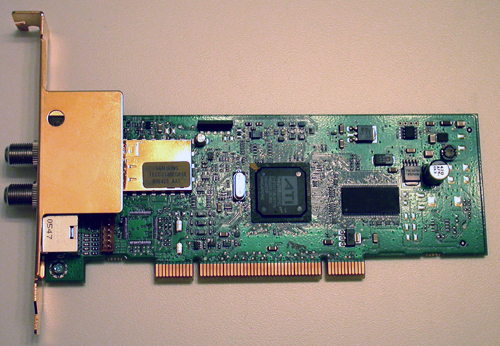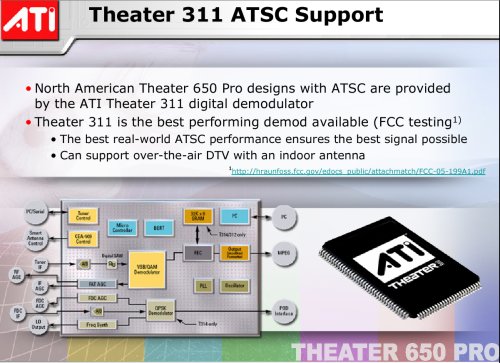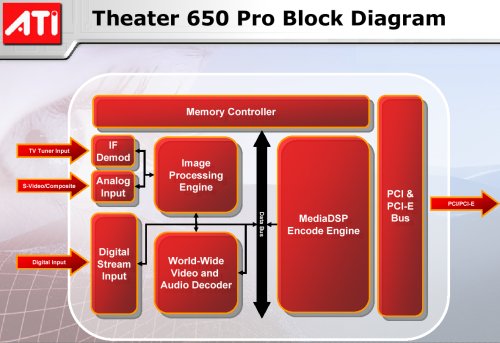The New Theater 650 TV Tuner Solution from ATI
by Josh Venning on June 14, 2006 4:00 AM EST- Posted in
- Smartphones
- Mobile
The Card
The Theater 650 may sport some new features, but the actual card is very similar to the older Theater 550 in size and appearance. The board we have is green in color, which is uncharacteristic of ATI parts (usually their cards are red, or in the A-I-W's case dark purple) but this is likely just because our card is a reference part, and the actual product color will depend on manufacturer preference. Aside from the color, the connections are exactly the same as on the 550, with the Antenna/FM and cable TV inputs, as well as an audio/video input at the bottom.


Being a reference part, our card didn't come with any kind of software bundle, but depending on which manufacturer distributes the card, it will most likely be packaged with the same types of software and accessories that 550 cards come with. Some of the partners who will be distributing the Theater 650 are well known companies like MSI , PowerColor, ASUS, Sapphire and VisionTek.
Architecture
The architecture of the Theater 650 is very similar to the 550, but with a few in changes. The 650 (for NTSC/ATSC countries) includes a Samsung mini-can tuner capable of tuning both analog and digital channels. The "mini-can", from what we understand, is an analog tuner (like the old tin-can tuners that wasted huge amounts of board space) shrunken down to fit in the same area as a silicon tuner. This is a best of both worlds situation where we don't need to worry about the board space of a tin-can, and we shouldn't run into the tuning speed issues we can sometimes see on silicon tuners.
The tuner feeds into both a Theater 311 demodulator and the Theater 650 chips. The Theater 311 digital demodulator supports over-the-air DTV (ATSC) with an indoor antenna. This is an in-house demodulator designed by ATI for their digital TV group, and ATI is very proud of the quality of this part. Testing the Theater 311 and the digital TV capabilities of the Theater 650 are beyond the scope of this article, but we will certainly be looking into these features in the future.

As the tuner feeds into the Theater 650 chip, the signal is internally demodulated and passed into the image processing engine. This is where functions including 3D comb filtering, motion adaptive noise reduction, de-interlacing, and edge enhancement take place. After this step, the cleaned up video flows over to the MediaDSP Encode Engine. Here, ATI is capable of performing the media center requisite MPEG-2 encoding in hardware. In addition to this feature, ATI has included the ability to encode to MPEG-4 (DivX and H.264) and WMV9, through the upcoming Catalyst Media Center software. These are features we are certainly interested in testing when we are able to do so.

We are quite happy to note that with all the additional filtering and feature capabilities ATI has included, they will also be enabling end users to adjust all of these settings at a very low level. Users who know exactly what they want from noise reduction, edge enhancement, and all the other filters will be able to tweak the settings as necessary.
Features
Let's talk a little bit now about the features of the Theater 650. Being the next installment of ATI's Theater series, it will naturally include many of the features of the previous Theater 550 like worldwide audio and NTSC and PAL video standards. However, this time around ATI has added many new features not included in their older cards, or in many competing solutions for that matter.
Firstly, as we mentioned in our introduction, one of the more interesting new features of the Theater 650 is its added digital capabilities. The card is touted by ATI as using next-generation DTV technology which is not yet available in consumer electronics. Basically, the Theater 650 provides digital TV support in ATSC (Advanced Television Systems Committee) for US, Canada, Mexico, and South Korea, as well as DVB-T (Digital Video Broadcasting Terrestrial) for European digital standards. Again, this is one of the first PC tuner cards to incorporate this feature, and certainly the first with the brand recognition of ATI.
ATI has also added some features to the 650 which address image quality, and should provide a better looking video stream. Motion adaptive 3D comb filtering has been included, which will provide sharper video and less false color. Edge enhancement has also been added to improve on image sharpness, and ATI has thankfully given users the option to turn this off, as many users prefer having control over this aspect. Better noise reduction is incorporated as well, and it is now motion compensated for sharper images with less static. Another feature is updated automatic gain and color control, which will provide brighter colors and faster brightness adjustment.
ATI has also designed the Theater 650 to be supported by the new Catalyst Media Center software which will replace ATI's previous Multimedia Center. There will be a new interface and it will provide much more user control over different aspects of video quality (like filters), which is a welcome feature.
All of these features add up to an impressive package which looks to be a significant improvement over the previous Theater cards by ATI. Specifications and buzzwords don't always correlate to a dramatic improvement in real-world applications, however, so we of course need to do some actual testing to see how image quality and CPU utilization on the Theater 650 compares to the Theater 550 and the NVIDIA DualTV MCE.
The Theater 650 may sport some new features, but the actual card is very similar to the older Theater 550 in size and appearance. The board we have is green in color, which is uncharacteristic of ATI parts (usually their cards are red, or in the A-I-W's case dark purple) but this is likely just because our card is a reference part, and the actual product color will depend on manufacturer preference. Aside from the color, the connections are exactly the same as on the 550, with the Antenna/FM and cable TV inputs, as well as an audio/video input at the bottom.


Being a reference part, our card didn't come with any kind of software bundle, but depending on which manufacturer distributes the card, it will most likely be packaged with the same types of software and accessories that 550 cards come with. Some of the partners who will be distributing the Theater 650 are well known companies like MSI , PowerColor, ASUS, Sapphire and VisionTek.
Architecture
The architecture of the Theater 650 is very similar to the 550, but with a few in changes. The 650 (for NTSC/ATSC countries) includes a Samsung mini-can tuner capable of tuning both analog and digital channels. The "mini-can", from what we understand, is an analog tuner (like the old tin-can tuners that wasted huge amounts of board space) shrunken down to fit in the same area as a silicon tuner. This is a best of both worlds situation where we don't need to worry about the board space of a tin-can, and we shouldn't run into the tuning speed issues we can sometimes see on silicon tuners.
The tuner feeds into both a Theater 311 demodulator and the Theater 650 chips. The Theater 311 digital demodulator supports over-the-air DTV (ATSC) with an indoor antenna. This is an in-house demodulator designed by ATI for their digital TV group, and ATI is very proud of the quality of this part. Testing the Theater 311 and the digital TV capabilities of the Theater 650 are beyond the scope of this article, but we will certainly be looking into these features in the future.

As the tuner feeds into the Theater 650 chip, the signal is internally demodulated and passed into the image processing engine. This is where functions including 3D comb filtering, motion adaptive noise reduction, de-interlacing, and edge enhancement take place. After this step, the cleaned up video flows over to the MediaDSP Encode Engine. Here, ATI is capable of performing the media center requisite MPEG-2 encoding in hardware. In addition to this feature, ATI has included the ability to encode to MPEG-4 (DivX and H.264) and WMV9, through the upcoming Catalyst Media Center software. These are features we are certainly interested in testing when we are able to do so.

We are quite happy to note that with all the additional filtering and feature capabilities ATI has included, they will also be enabling end users to adjust all of these settings at a very low level. Users who know exactly what they want from noise reduction, edge enhancement, and all the other filters will be able to tweak the settings as necessary.
Features
Let's talk a little bit now about the features of the Theater 650. Being the next installment of ATI's Theater series, it will naturally include many of the features of the previous Theater 550 like worldwide audio and NTSC and PAL video standards. However, this time around ATI has added many new features not included in their older cards, or in many competing solutions for that matter.
Firstly, as we mentioned in our introduction, one of the more interesting new features of the Theater 650 is its added digital capabilities. The card is touted by ATI as using next-generation DTV technology which is not yet available in consumer electronics. Basically, the Theater 650 provides digital TV support in ATSC (Advanced Television Systems Committee) for US, Canada, Mexico, and South Korea, as well as DVB-T (Digital Video Broadcasting Terrestrial) for European digital standards. Again, this is one of the first PC tuner cards to incorporate this feature, and certainly the first with the brand recognition of ATI.
ATI has also added some features to the 650 which address image quality, and should provide a better looking video stream. Motion adaptive 3D comb filtering has been included, which will provide sharper video and less false color. Edge enhancement has also been added to improve on image sharpness, and ATI has thankfully given users the option to turn this off, as many users prefer having control over this aspect. Better noise reduction is incorporated as well, and it is now motion compensated for sharper images with less static. Another feature is updated automatic gain and color control, which will provide brighter colors and faster brightness adjustment.
ATI has also designed the Theater 650 to be supported by the new Catalyst Media Center software which will replace ATI's previous Multimedia Center. There will be a new interface and it will provide much more user control over different aspects of video quality (like filters), which is a welcome feature.
All of these features add up to an impressive package which looks to be a significant improvement over the previous Theater cards by ATI. Specifications and buzzwords don't always correlate to a dramatic improvement in real-world applications, however, so we of course need to do some actual testing to see how image quality and CPU utilization on the Theater 650 compares to the Theater 550 and the NVIDIA DualTV MCE.










78 Comments
View All Comments
Mumrik - Thursday, June 15, 2006 - link
Still, why didn't you touch on the Hardware DRM?None of us know what this element means for the card and it MIGHT just be the deal breaker that makes this card WORSE than the 550.
You need to look into stuff like that, or somebody's going to make a purchase based on this "review" and quite possibly be very disappointed.
LoneWolf15 - Thursday, June 15, 2006 - link
Below are the updates I found for the Hauppauge WinTV PVR-150, the card that has mostly replaced the PVR-250 with better quality and a single chip solution
http://www.hauppauge.com/pages/support/support_pvr...">http://www.hauppauge.com/pages/support/support_pvr...
Name: pvr150_500_basedriver_2043_24103.zip
Size: 2.2MB
Updated: April 13, 2006
WinTV2000 application update for the WinTV-PVR-150
Name: wintv2k411_23347.exe
Size: 2.5 Mb
Updated: Dec. 15, 2005
WinTV video decoder update
Name: hcwsmd05_23290.exe
Version: 5.0_23290
Size: 1996K
Updated: Oct. 17, 2005
I'd call that updated in the past year. When video cards are updated, Anandtech and others test to see if increased performance and/or image quality results. Are you saying the same should not be done with TV Tuner cards?
P.S. I could be wrong, but I don't recall you testing the WinTV PVR-150, which is considered by most HTPC enthusiasts to be a much better replacement of the PVR-250. If I'm wrong, apologies. If I'm right, then Hauppauge's cards have changed indeed since you tested the PVR-250.
BigLan - Thursday, June 15, 2006 - link
"The Hauppauge cards haven't really changed at all in over a year. Do we need to include socket 754 Athlon 64 and Pentium 4 478 in current CPU articles? Do we need to talk about the Radeon X800 and GeForce 6800 cards in new GPU reviews?"Two problems with this, Jarred. First is that the Hauppauge 250 got replaced with the 150, which offered better image quality and a lower price. Anand has never compared the 150 to the 550, or any other card. Sure you can say it's similar to the MCE500, but you didn't mention that in this article, only the 250.
Next up is that you actually did compare the X800 and 6800 cards to modern GPUs in the Oblivion article.
Crucial - Thursday, June 15, 2006 - link
If the S754 and S478 cpus were the last ones to be made and still the more popular cpu your darn right you do. The comparison to video cards and cpu's doesn't hold up because there aren't new tuner cards coming out every 6 months. Many people here don't agree with the statements that the 650 screenshots look better. Just because somethings new doesn't mean it's automaticaly better.
As for that comment, are you writing these reviews for yourself or for the readers of the site? With an attidude like this it's no wonder the review doesn't cover half of what it should.
Basically it sounds to me like you only have a Theatre550 card and dont want to take the time or spend the money to review a hauppage card. That or ATI is pulling the strings and won't let you. If thats the case just say so and alot of the flack will go away. You can try and justify your attitude towards these reviews but it is not what a majority of the readers want to see.
hondaman - Wednesday, June 14, 2006 - link
Thats some seriously flawed logic. In every review, one _always_ compares, HEAD TO HEAD, the king(s) of the hill vs. the newcommers. This goes for cpus, video, hd's, and yes, even capture cards.
The bottom line duty of a capture card is to capture video. It doesnt matter an ounce that you previously reviewed a card. Image quality is something we must see for ourselves, and allow us to decide what looks best. That means running the SAME tests on the SAME capture cards.
jeremyk442 - Wednesday, June 14, 2006 - link
Am I the only one who seems to think that the 650 looked worse than the 550 on the tomato shot? The differences in the stills were extremely subtle and give no indication of how much difference you would notice while using it. And this whole review felt like an advertisement for ati's new chip rather than a valid comparison (especially the image quality).JNo - Saturday, June 17, 2006 - link
I agree. The 650 was praised (vs the 550) for warmer colours but in actual fact, the 550 shot was the only one where the woman's skin tone seemed more natural and you could make out extra *details* on her that were smoothed over in the other 2 cards e.g. just above and below her lips if I remember correctly. "Brighter" colours aren't always better if they just create colours that aren't in the signal. Hey, we could all just turn up the colour bar on our TVs for a better picture if that were the case...BigLan - Wednesday, June 14, 2006 - link
Looking closer at the tomato shot, I think there's something messed up in the GualTV test. It looks like there's some ghosting going on, which is either a problem with the tuner chip or a problem with the setup. I don't believe that the dual tuner could have that big an issue tuning channels without the community having noticed by now, which suggests the test setup is wrong.mostlyprudent - Wednesday, June 14, 2006 - link
This is a relatively new area of interest for me. Can some one point me to some information on which, if any, of these cards supports a signal from setalite sources? I have a dual tuner receiver and want to use my PC as the other output (my DVR is filling up and I would like to capture some of the prgramming to archive on my hard drive). Wow, I feel like a newbie!SHSPVR - Wednesday, June 14, 2006 - link
No it do not supports a signal direct from setalite LNB you must used a sat receiver and I hate tell you but dual tuner sat receiver suck becuase of the fact that there are NO Blaster that support UHF Transmit signal so there for your SOL with 2nd TV output but you can setup the 1st TV output becuases it base on Standard IR Transmit signal.